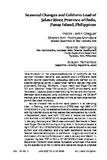Seasonal changes and coliform load of Jalaur river, province of Iloilo, Panay island, Philippines
Share
Abstract
Determination of the presence/absence of coliforms as the pollution indicator bacteria, total coliform count (TCC) and fecal coliform counts specifically Echerichia coli were carried out on specific sampling points in Jalaur River namely: Banban Pequeño (upstream), Calinog, Moroboro, Dingle, Passi near Sugar Central Mill and National Power Corporation (NPC) (midstream), and Nabitasan, Leganes (downstream) during the wet and dry months. Samples were analyzed using a defined technology, the Colilert® method, and its accuracy was verified with the conventional method (APHA Standard Methods).
Results showed that coliforms were present in all sampling sites. In Calinog, total coliform count (TCC) was high (900 x101 MPN/100 ml) in July. Increased coliform abundance was associated with high rainfall due to animal wastes that were carried by runoffs. In September, Passi, near NPC, TCC and E. coli counts were 640 x101 and 630 x 101 MPN/100 ml, respectively. Reduction in counts in January, February and March was observed. Sediments in Passi near Sugar Central Mill during milling time in February showed a high TCC of 116 x 104 MPN/100 ml which was attributed to reduced current and disturbance, and silty loam sediments texture that favored bacterial adsorption to sediments. Dingle site exhibited a domination of other coliforms over E. coli in January and March. In Leganes, highest TCC of 551 x 101 MPN/100 ml was obtained in September. Coliform loads varied by season which was influenced by the availability of the nutrients and tolerance range to physical and chemical factors in the environment. Variability of the resultant interaction can also be attributed to climate changes such as extreme weather events—El niño phenomenon and increased nutrient loadings during heavy rains hence, increased coliform concentration in the river. The presence of coliforms in Jalaur River is indicative of contamination that can be aggravated by climate changes and implies that a potential health risk associated with pathogens causing water-borne diseases is present.
Suggested Citation
Lantin-Olaguer, I., Pedrajas-Mendoza, S. A., Pakingking, R. V., Jr., & Yamamoto, A. (). Seasonal changes and coliform load of Jalaur river, province of Iloilo, Panay island, Philippines. Silliman Journal , 5(1), 247-264. http://hdl.handle.net/10862/2223
Subject
Koleksi
- AQD Journal Articles [1215]


